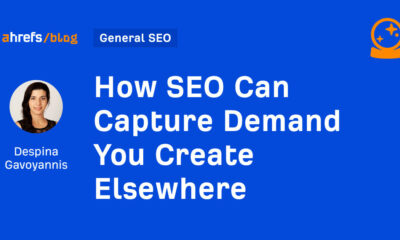MARKETING
What are Instagram Guides? [+ How to Create One]
![What are Instagram Guides? [+ How to Create One] What are Instagram Guides? [+ How to Create One]](https://articles.entireweb.com/wp-content/uploads/2022/04/What-are-Instagram-Guides-How-to-Create-One.jpgkeepProtocol.jpeg)
If you’re on Spotify, chances are you’ve curated a playlist with all your favorite songs — and rearranged them in a specific order. But did you know you can do something similar on Instagram?
Enter the Instagram Guide — a tool that allows you to curate your favorite Instagram posts, Reels, or Lives in one location, which you can share with your community. For marketers, it’s a great way to revive old content, promote products, and introduce your brand.
Let’s take a closer look at Instagram Guides, how you can leverage them in your marketing strategy, and how to make one in six steps.
What is an Instagram Guide?
In short, an Instagram Guide is a collection of posts, Reels, or Lives — either from your own feed or from others.
![What are Instagram Guides? [+ How to Create One] Instagram-guides](https://articles.entireweb.com/wp-content/uploads/2022/04/What-are-Instagram-Guides-How-to-Create-One.png)
All guides revolve around a single topic, story, or idea. For instance, you could create a gift guide, product round-up, or exercise routine — but more on that later.
Once you create a guide, it will live under a public tab in your profile that users can visit anytime. You can also share it to your Instagram Story for more visibility.
There are three types of guides on Instagram — places, products, and posts.
- Places is for sharing travel-related or location-specific content. For instance, you could share your road trip itinerary or your favorite coffee shops in X location.
Example: The Most Instagrammable Places in Phoenix.
- Products is for showcasing products from Instagram Shops. You could create anything from product tutorials to listicles of your favorite products or brands.
Example: My 8 Must-Have Products for Sensitive Skin.
- Posts is for articles, commentary, or anything interesting you’ve shared or saved from others. This type focuses less on visuals and more on your storytelling abilities.
Example: How to Build a Healthy Morning Routine.
With a solid understanding of Guides, let’s discuss the benefits of using them in your Instagram marketing.
Instagram Guides for Marketing
Instagram has countless features for marketers — but what makes guides stand out from the crowd?
Check out the top benefits of using Instagram Guides in your marketing:
1. Revive your old content
Content on Instagram has a short lifecycle. After hitting the “Post” button — and watching the likes pour in for a day or two — your content sits on your feed, collecting dust.
With guides, you can shine a spotlight on your past content. When a user clicks on an individual post in your guide, it directs them to the original post — giving it a new lease on life.
2. Drive traffic to your blog or website.
Guides are a great way to share your tips, tricks, advice, and recommendations on specific topics — but you shouldn’t reveal everything.
Instead, use the guide to summarizing one or two points from your blog posts — then encourage users to visit your blog for more details (or more tips). That way, you can drive traffic to your other channels.
3. Introduce your brand.
Instagram Guides are a great way to introduce both new and current customers to your brands and its values. Use them to highlight social responsibility work, new milestones, behind-the-scenes content, or new initiatives.
For example, fashion marketplace Vestiaire Collective highlights its brand values by posting guides on building a more sustainable wardrobe and the power of upcycling.
![What are Instagram Guides? [+ How to Create One] vestiaireco](https://articles.entireweb.com/wp-content/uploads/2022/04/1649806532_416_What-are-Instagram-Guides-How-to-Create-One.png)
4. Leverage user-generated content.
With Guides, you can combine content from other users with your own — which presents an opportunity to leverage user-generated content.
For example, suppose you run a sunglass brand. You could create a guide titled, say, “The Trendiest Sunglasses of 2022” that contains photos of your customers wearing your products. What better way to leverage UGC, promote your products, and attract new customers — all at the same time.
5. Promote your products — without being too sales-y.
If you struggle with promoting your products without sounding like an infomercial, Instagram Guides are a great way to strike that balance.
Back to the sunglass example above — if you were to create a guide for your new collection, you could add value to the reader by including advice, tips, or tricks within the guide. Then, title your guide in a way that puts the value front-and-center, such as “How to Style Oversized Sunglasses.”
This is one way to subtly promote your products without it being the center of attention.
How to Make a Guide on Instagram
Creating a guide is relatively simple, but you’ll need the latest version of Instagram before you can start. It’s also a good idea to brainstorm what type of guide you want to create — and take note of the content you want to include. Then, follow these steps:
1. Navigate to your Instagram profile and tap the plus (+) button. This opens a menu with options of what you can post on Instagram. Tap “Guide.”
![What are Instagram Guides? [+ How to Create One] IMG-3564](https://articles.entireweb.com/wp-content/uploads/2022/04/What-are-Instagram-Guides-How-to-Create-One.jpg)
2. Next, tap on the type of Instagram guide you want to create. You can choose from Places, Products, or Posts.
![What are Instagram Guides? [+ How to Create One] IMG-3565](https://articles.entireweb.com/wp-content/uploads/2022/04/1649806532_476_What-are-Instagram-Guides-How-to-Create-One.jpg)
3. Select the content you want to add to your guide. This can be content you’ve shared or saved from others.
![What are Instagram Guides? [+ How to Create One] IMG-3567](https://articles.entireweb.com/wp-content/uploads/2022/04/1649806532_307_What-are-Instagram-Guides-How-to-Create-One.jpg)
4. From here, you’ll need to write a few details about your guide — namely the title and summary. You’ll also need to upload a cover photo if you want to change the one Instagram provides.
![What are Instagram Guides? [+ How to Create One] IMG-3570](https://articles.entireweb.com/wp-content/uploads/2022/04/1649806532_842_What-are-Instagram-Guides-How-to-Create-One.jpg)
5. As you scroll through the guide, add titles and descriptions, commentary, or thoughts to each post.
![What are Instagram Guides? [+ How to Create One] IMG-3569](https://articles.entireweb.com/wp-content/uploads/2022/04/1649806532_419_What-are-Instagram-Guides-How-to-Create-One.jpg)
6. Once you’re happy with the guide, click Share.
Instagram Guides are all about repurposing content. So take a look at your feed and find new stories you can tell. Leverage the tips in this article to make your guides an effective top-of-funnel marketing strategy to engage users, promote your products, and introduce your brand.

![What are Instagram Guides? [+ How to Create One] New Call-to-action](https://articles.entireweb.com/wp-content/uploads/2022/01/1641295458_639_How-to-Post-on-Instagram-A-Step-by-Step-Guide.png)


![How to Create A Website to Sell Products In 8 Steps [+6 Expert Tips] How to Create A Website to Sell Products In 8 Steps [+6 Expert Tips]](https://articles.entireweb.com/wp-content/uploads/2024/10/1727868370_How-to-Create-A-Website-to-Sell-Products-In-8.webp-400x240.webp)
![How to Create A Website to Sell Products In 8 Steps [+6 Expert Tips] How to Create A Website to Sell Products In 8 Steps [+6 Expert Tips]](https://articles.entireweb.com/wp-content/uploads/2024/10/1727868370_How-to-Create-A-Website-to-Sell-Products-In-8.webp-80x80.webp)








You must be logged in to post a comment Login